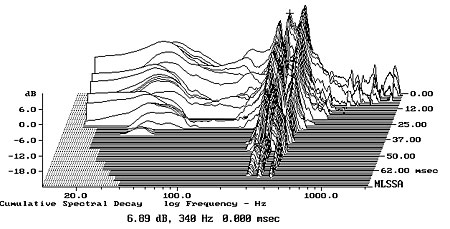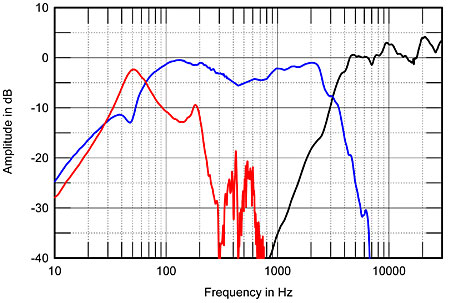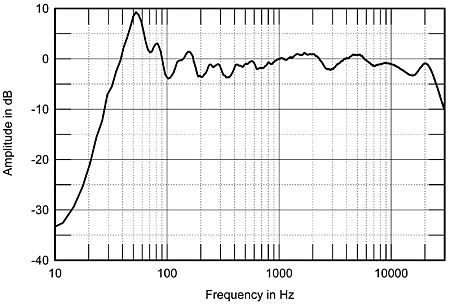| Columns Retired Columns & Blogs |
ProAc Response D28 loudspeaker Measurements
Sidebar 3: Measurements
The ProAc Response D28 is both less sensitive than the norm and less sensitive than its own specification of 88.5dB/W/m. My estimate of the speaker's voltage sensitivity on its tweeter axis was just 84.6dB(B)/2.83V/m, though it fair to note that this is slightly higher than that of the older Response 2.5. To reach useful sound-pressure levels, it will need to be used with an amplifier capable of swinging plenty of volts. However, its impedance plot (fig.1) reveals it to be an extremely easy load for an amplifier to drive. The magnitude drops below 8 ohms only briefly in the upper bass, and remains above 11 ohms for through much of the audioband. Tube amplifiers can be used from their 8 ohm taps without their breaking a sweat. I am not surprised Mikey liked the sound of the ProAcs when he drove them with his tubed Music Reference amplifier.

Fig.1 ProAc Response D28, electrical impedance (solid) and phase (dashed). (2 ohms/vertical div.)
There are a couple of small discontinuities in the impedance traces, one at 180Hz and the other just above 400Hz. Checking the panels' vibrational behavior with an accelerometer, I found nothing untoward at the lower frequency. However, there were three strong resonant modes on all cabinet surfaces at 297, 340, and 434Hz (fig.2). Peculiarly, only the highest-frequency mode coincides with a wrinkle in the impedance traces. These are low enough in frequency and high enough in level to add a small degree of overhang to transient sounds in the lower midrange, I feel. I wonder if these modes contributed to the "warmth" MF noted in his auditioning, though it is fair to note that he felt this was associated with what was happening at lower frequencies.

Fig.2 ProAc Response D28, cumulative spectral-decay plot calculated from the output of an accelerometer fastened to the center of the sidewall level with the woofer (MLS driving voltage to speaker, 7.55V; measurement bandwidth, 2kHz).
Turning to the drive-units' acoustic output, fig.3 shows their individual outputs measured, in the farfield, on the tweeter axis above 350Hz (tweeter, black trace; woofer, blue trace); and, in the nearfield, below 350Hz (woofer, blue trace) and 750Hz (port, red trace). The crossover appears to be set at 3.1kHz, the tweeter rolling in with an approximate 18dB/octave slope. The tweeter is basically flat within its passband, but is set 2–3dB too high in level compared with the woofer's level at 1kHz. The woofer peaks a little at the top of its passband before rolling out with a very steep slope. The trace features the usual upper-bass hump that results from taking this measurement in the nearfield, with the expected minimum-motion notch evident at 48Hz, which is the frequency of the saddle in the impedance-magnitude trace. The port peaks at 50Hz, but its smooth upper-frequency rollout is disturbed by a second peak at 180Hz, which is one of the frequencies of the discontinuities in the fig.1 impedance traces. Presumably, this is due to an internal air-space resonance of some kind and again I suspect it contributes to the speaker's "warmth."

Fig.3 ProAc Response D28, acoustic crossover on tweeter axis at 50", with the nearfield responses of the woofer (blue) and port (red), plotted in the ratios of the square roots of their radiating areas below 350Hz and 750Hz, respectively.
Fig.4 shows the ProAc's farfield response above 300Hz, averaged across a 30° horizontal angle on the tweeter axis. It nicely correlates with MF's finding that the ProAc D28 "pushes forward slightly in the upper mids" with "a slightly bright top end." You called it correctly, Mikey. Below 300Hz, the graph shows the complex sum of the nearfield woofer and port outputs. The port resonance at 180Hz results in a rather disturbed-looking upper bass, though once the nearfield hump is taken into account, the D28 can be seen to extend at full level down to 42Hz or so, the frequency of the low E-string of both the double bass and the bass guitar. As MF noted, the D28's low end doesn't extend particularly deep. I also noted some doubling when I was driving the speaker with bass tones at high levels, with some unloading of the woofer cone below the port resonance. You can expect only so much from a 6.5" woofer.

Fig.4 ProAc Response D28, anechoic response averaged across 30° horizontal window on tweeter axis at 50" and corrected for microphone response, with the complex sum of the nearfield responses plotted below 300Hz.
The ProAc's lateral dispersion is shown in fig.5, with the off-axis traces on the tweeter side of the baffle at the front of the graph. The contour lines are generally evenly spaced, but there is the usual off-axis flare at the base of the tweeter's passband, which will contribute to the feeling that the speaker is balanced on the forward side in the upper midrange and low treble. The 1" silk-dome tweeter maintains its dispersion to around 15kHz—almost half an octave higher than the typical drive-unit of this size. In the vertical plane (fig.6), the crossover suckout at extreme angles occurs at 3.64kHz rather than the expected 3.1kHz, but this graph does suggest that listening a little higher than the D28's tweeter axis, which is 37" from the floor, might ameliorate the slightly forward upper mids.

Fig.5 ProAc Response D28, lateral response family at 50", normalized to response on tweeter axis, from back to front: differences in response 90–5° off axis on woofer side of baffle, reference response, differences in response 5–90° off axis on tweeter side of baffle.

Fig.6 ProAc Response D28, vertical response family at 50", normalized to response on tweeter axis, from back to front: differences in response 15–5° above axis, reference response, differences in response 5–10° below axis.
As usual, I drove over to Michael Fremer's listening room, in deepest, darkest New Jersey, to measure the Response D28's spatially averaged in-room response. The result, taken using the Musical Fidelity monoblocks, is shown in fig.7. The midbass peaks up, due to the unavoidable boundary reinforcement in Mikey's room—where speakers inevitably must be placed fairly near the corners—but useful output is available down to 32Hz or so. Higher in frequency, the output is smooth, but with a slight rising trend. Again, the shape of this trace correlates with Mikey's description of the D28's balance: upper midrange a little forward, with a slightly exaggerated top end.

Fig.7 ProAc Response D28, spatially averaged, 1/6-octave response in MF's listening room.
Turning to the time domain, the Response D28's step response on the tweeter axis is shown in fig.8. The tweeter can be seen to be connected in inverted acoustic polarity, which allows the decay of its step to smoothly integrate with that of the woofer, which is connected in positive polarity. The decay of the woofer's step is overlaid with some ringing that, from the D28's cumulative spectral-decay plot (fig.9), appears to be associated with a step in the on-axis response at 2.35kHz. This graph is superbly clean in the region covered by the tweeter, however.

Fig.8 ProAc Response D28, step response on tweeter axis at 50" (5ms time window, 30kHz bandwidth).

Fig.9 ProAc Response D28, cumulative spectral-decay plot on tweeter axis at 50" (0.15ms risetime).
ProAc's Response D28 offers respectable measured performance, but it does have a bit of measured character that will require careful system matching to get the best from it.—John Atkinson
- Log in or register to post comments




































